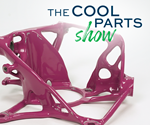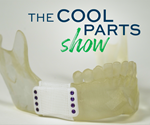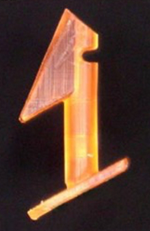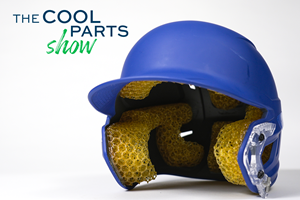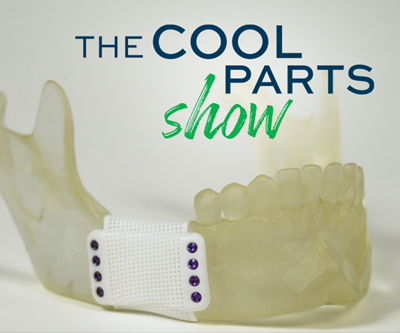Micro 3D Printing for Tiny Connectors: The Cool Parts Show #20
Microscale additive manufacturing offers an alternative to micromolding and micromachining. On this episode of The Cool Parts Show, 3D printed electrical connectors are our smallest cool part yet.
The well-known benefits of additive manufacturing (AM) include geometric complexity and reduced lead time, but Boston Micro Fabrication (BMF) is advancing a potential benefit that is less well known. That is, AM can provide an efficient and accessible means of making tiny parts — parts that are so small it might take a microscope to see them clearly.
A 3D printed electrical connector provides an example. Making the part through injection molding is challenging because of the expertise needed to make a microscale mold, while producing the part on BMF’s fine-resolution 3D printer is straightforward by comparison. On this episode, we talk about AM as an alternative to micromolding and micromachining.
Related resource: BMF 3D printer
Transcript:
Peter Zelinski, Additive Manufacturing
Here's an advantage of additive manufacturing we haven't talked about: 3D printing is potentially a solution for super tiny parts. We go really small on this episode of The Cool Parts Show.
Stephanie Hendrixson, Additive Manufacturing
Season Three of The Cool Parts Show is brought to you by Carpenter Additive. The company's Athens, Alabama, Emerging Technology Center is an end-to-end additive manufacturing production facility, with everything from materials development through postprocessing under one roof, ready to help you with your next metal 3D-printing job. Check them out at CarpenterAdditive.com. Now, back to the show.
Peter Zelinski
I'm Pete.
Stephanie Hendrixson
I'm Stephanie.
Peter Zelinski
This is The Cool Parts Show, our show all about cool 3D-printed parts made by manufacturers, maybe manufacturers like you.
Stephanie Hendrixson
So 3D-printed parts, but I'm getting the sense this is another one of those surprise reveal episodes because there's no part on the table, Pete.
Peter Zelinski
I brought a part — I brought you many parts. Here is an advantage of additive manufacturing I don't hear talked about much at all.
Stephanie Hendrixson
And you said parts not part. And I still don't see them. Where are the parts?
Peter Zelinski
Take a look in your coffee cup, where I have brought you 500 3D-printed parts.
Stephanie Hendrixson
So this is not what I usually drink in the morning.
Peter Zelinski
Additive manufacturing is a potential solution for making tiny, tiny, tiny parts and possibly presents an easy way to do it.
Stephanie Hendrixson
Okay, so that's interesting because I feel like one of the challenges with 3D printing that people often point out is this issue of resolution. And how, you know, how small can you go, how fine of features can you do, but you're saying that 3D printing actually is the right solution for these tiny little parts.
Peter Zelinski
Potentially! These are tiny little electrical connectors, tiny little connectors for a very compact electronic assembly. They were made by Boston Micro Fabrication (BMF) and a part like this, if not for 3D printing, would otherwise be made by injection molding. The prospect of making a mold that tiny with features, cavity and a core that tiny, that precise — it can be done, companies do it, but it's challenging, and a mold like that is expensive.
Stephanie Hendrixson
Okay, so I see the appeal of getting away from tiny little molds for parts like these, but the 3D-printing method is not entirely obvious. So Boston Micro Fabrication, what's the technology they're using?
Peter Zelinski
So BMF is doing DLP, digital light processing. A bath of resin and optics cure an entire layer, one layer at a time. It's not a point-by-point process. There are other 3D-printing makers who use DLP, but they use it for more macro-size components. What BMF brings is that they add a couple things to the machine. One is there's really precise x-y motion. In fact, the bed of resin is what is moving in x and y so the optics can stay stationary, and the bed is descending minutely layer by layer. Other DLP systems kind of orient so the part is suspended. We'll talk more about that. So precise x-y motion combined with very precise optics form the part. This is John Kawola. He is the CEO of BMF and he has a little more to say about that.
John Kawola, Boston Micro Fabrication
Getting fine resolution is dependent on the process. So if you're using a FDM process, it's often about the nozzle size. If you're using a laser-based process, it's often about the beam width to be able to get the resolution that you're looking for. In a DLP process, it's really about the image resolution, similar to when you're looking at your television: the higher the resolution, the sharper the image. We're using a 1080p DLP projector, but then we're also using a lens to really be able to focus that resolution even finer down to the 10-micron optical resolution that we're really looking for. So that's the key to get the pixels to be small and the resolution to be where we have it for high performance.
Stephanie Hendrixson
Okay, so that kind of addresses my question about resolution. It's a combination of that projector and then the lens that lets you get that really fine detail.
Peter Zelinski
Yeah, so that's what achieves what they call micro-scale 3D printing.
Stephanie Hendrixson
Okay micro-scale, what do you mean by that?
Peter Zelinski
Right, so parts and part features that are really, really tiny but still visible, right? So we're not talking about microscopic work necessarily, we're not talking about nano-scale work. But we're talking about features that fall in the realm where these parts would otherwise be produced through microinjection molding, or micromachining. Put a pin in that because there's a micromachining-related solution we'll get to too. But it's not just for tiny parts like this, not just for that, because there are also features of larger parts where this could make sense, too. Here's a more macro-scale part. At a glance, you might think this makes sense for a more macro-scale 3D printer. This is a chip socket. But if you look closely, you can see there's this array of tiny, tiny holes. And those tiny holes in this case are the feature that is produced through micro-scale 3D printing.
Stephanie Hendrixson
Okay, so this is a solution, not just for these tiny little parts, but also for larger parts that have fine features, or things that would be maybe difficult or challenging to injection mold, for instance.
Peter Zelinski
Yeah, applications: tiny electrical connectors, tiny little medical components and microfluidics parts. And also just prototypes for parts that are really, really tiny. If the process and the tooling are really hard for a part that's ultimately going to be made through a conventional process, it still makes a lot of sense to use 3D printing to get that part design just right before you have to make that investment. Prototyping is where BMF initially saw the promise of this technology and what they've addressed so far, but they also recognize that on a cost-comparison basis, for some production applications of really tiny parts or parts with really tiny features, maybe this 3D-printing platform really is the way to go.
Stephanie Hendrixson
Okay, so you mentioned cost savings. Sometimes we talk about additive as reducing the amount of material that's used. But there's so little material here to begin with, I feel like the cost savings is probably more from the process side, right?
Peter Zelinski
Yeah. So yeah, good point. In conventional manufacturing “little” creates big challenges. The injection mold to make a part this tiny, those tiny little features machined really precisely into the mold, there are companies that know how to do that, mold makers who know how to do that, but not a large number of them and it's challenging work. Similarly, for metal parts that are micromachined. In some cases, that micromachining is done with cutting tools so small in diameter, you can barely see them. And tools like that create processing challenges, handle-with-care type challenges in the setup and the use of those tools. Again, only so many providers out there are able to do that kind of really fine, tiny work. But a 3D-printing process that has the accuracy and the resolution and the fineness built in, by comparison, it's a relatively easy way to produce these tiny parts or parts with these tiny, tiny features. John Kawola actually has a little bit more to say about that. Let's listen to him.
John Kawola
For a lot of small parts for whether it's electrical connectors, or whether it's other applications, the traditional methods for making that either are what's often called microinjection molding — it's a subset of general injection molding — or micromachining. So very, very small parts. In a lot of ways, the smaller the part, the more expensive the process. So that's the challenge: the tooling that would be required for molding or the setup, and the equipment that would be required for CNC machining, are in some cases, an order of magnitude more expensive than if you're just making a standard plastic part or metal part today. I think that the promise of 3D printing is it just makes that easier. Parts that are complex to mold or difficult to mold or complex to machine are relatively easy to 3D print. And so I think that the promise is that this technology can displace some of those traditional methods for manufacturing.
Stephanie Hendrixson
Okay, so the thing that's kind of striking about that is that a lot of 3D-printing processes, and DLP is one of them, involves support structures. Once you finish the print you've got to somehow remove those support structures. How do you do that with these tiny little parts?
Peter Zelinski
I'm so glad you asked about that. I mentioned how their system has the build platform descending minutely; the part grows up from below. In the resin bath, the buoyancy of that resin, because these parts are so tiny so fine, just that buoyancy provides just enough support. In many cases, the float is enough to sustain the parts and support them so no structures are needed.
Stephanie Hendrixson
Ok no support structures. That is really cool.
Peter Zelinski
Yeah. Let me show you another example of a part. Here's a case where micro-scale 3D printing potentially can replace a metal part. This is a glaucoma stent. Conventionally, it's made of titanium. It is micromachined and the potential 3D-printed replacement is made from a biocompatible polymer. Right now, this stent requires two surgeries: one to put it in, and one to take it out. The biocompatible alternative potentially dissolves in the body, eliminating that second surgery.
Stephanie Hendrixson
Wow. So changing the process allows for this material change, which completely changes the nature of the surgery — makes it so much easier. Okay, so you've shown me a couple of different applications now, the glaucomas stent, this connector and the chip socket. What other parts can this be used for?
Peter Zelinski
Yeah, so potentially different sectors, different applications. What BMF is really thinking about now for its next step is moving into production, using this platform as a possibility for repetitive manufacturing of these tiny, tiny parts. Here's John Kawola one more time.
John Kawola
We think the platform we have today serves our prototyping needs and we've got a range of materials that serve those needs well. We think the speed and the productivity of the platform is quite good for prototyping needs. But when you're really moving toward production applications, you need to check three boxes. The first box is that the part itself needs to match the requirements of the end part in terms of accuracy, surface finish and detail. We think we've already checked that box. The second box is material properties. So the material needs to, if it doesn't match 100%, it needs to be good enough or close enough. This covers mechanical properties, thermal properties and perhaps dielectric properties, depending on the application. That's the second box to check. We're working on that both internally on the material side and with partners to develop materials to match those production materials. The third box is speed: if you're trying to take a 3D-printing application and use it to displace a current traditional manufacturing method, the economics need to be there. Perhaps you can pay a little bit more for the convenience, the promise of distributed manufacturing and not having tooling and inventory, but it can't cost much more. It needs to be able to meet the economic requirements of the customer. In a lot of ways comes down to material cost, it comes down to equipment cost and it comes down to speed. And I often think that speed equals money, you know, if you have a slow machine that means you need a lot of machines, which may not be economical. When we really think about what needs to happen to move this technology forward, it's materials development and speed. Those are both on our product roadmap.
Stephanie Hendrixson
Okay, so one thing John mentioned that we haven't talked about yet is speed. Pete, you said there are 500 parts here? How long did it take to print these?
Peter Zelinski
Sure. These were printed in batches of 150, about two hours build time per batch. So do the math there: 500 parts in something like seven hours.
Stephanie Hendrixson
Okay, so 500 parts in less than an eight-hour shift?
Peter Zelinski
Yeah.
Stephanie Hendrixson
Pretty cool. Okay, so I think I got this. These parts are connectors. They are in a range that we would call the micro scale. They're not microscopic. They're not nano-scale, but they are very small and very detailed. They were made by a company called Boston Micro Fabrication, which uses a high-resolution DLP process to print small parts like this and other parts with fine features. This is a cost-effective solution to microinjection molding or micromachining, and it has a lot of diverse applications: everything from the medical industry, to optics to electronics.
Peter Zelinski
Exactly right. I think that'll do it. Thank you for watching The Cool Parts Show.
Stephanie Hendrixson
If you want to tell us about a cool part that you're making, email us: CoolParts@Additive Manufacturing.Media.
Peter Zelinski
If you've just found us, if you're watching us for the first time, you can go back and watch all of our existing episodes at our new URL, TheCoolPartsShow.com.
Stephanie Hendrixson
And if you like the show, we hope you'll subscribe, leave us comment and tell a friend. Thanks for watching.
Peter Zelinski
Thank you.
Stephanie Hendrixson
Thank you to our sponsor Carpenter Additive. Listen to additive manufacturing podcasts, attend webinars and learn more at CarpenterAdditive.com.
Related Content
Understanding PEKK and PEEK for 3D Printing: The Cool Parts Show Bonus
Both materials offer properties desirable for medical implants, among other applications. In this bonus episode, hear more from Oxford Performance Materials and Curiteva about how these companies are applying PEKK and PEEK, respectively.
Read More8 Cool Parts From Formnext 2023: The Cool Parts Show #65
New additive manufacturing technologies on display at Formnext were in many cases producing notable end-use components. Here are some of the coolest parts we found at this year’s show.
Read More3D Printed Titanium Replaces Aluminum for Unmanned Aircraft Wing Splice: The Cool Parts Show #72
Rapid Plasma Deposition produces the near-net-shape preform for a newly designed wing splice for remotely piloted aircraft from General Atomics. The Cool Parts Show visits Norsk Titanium, where this part is made.
Read More3D Printed Lattices Replace Foam for Customized Helmet Padding: The Cool Parts Show #62
“Digital materials” resulting from engineered flexible polymer structures made through additive manufacturing are tunable to the application and can be tailored to the head of the wearer.
Read MoreRead Next
Generative Design Improves Micromobility FUV: The Cool Parts Show #19
Arcimoto’s lightweight “Fun Utility Vehicle” gets even lighter thanks to parts that could only come from additive manufacturing. On this episode of The Cool Parts Show, some of the craziest automotive parts you have seen.
Read MoreBioceramics for Bone Replacement: The Cool Parts Show #18
A mandibular cage made up of two different bioresorbable ceramics points to the future of bone graft and reconstructive surgeries in this episode of The Cool Parts Show.
Read MoreCan Microscale 3D Printing Reduce Surgeries for Glaucoma Sufferers?
Boston Micro Fabrication (BMF) is exploring this promise. Eye stents are made of metal today. Fine-detail additive manufacturing can enable polymer instead, improving patient experience.
Read More

